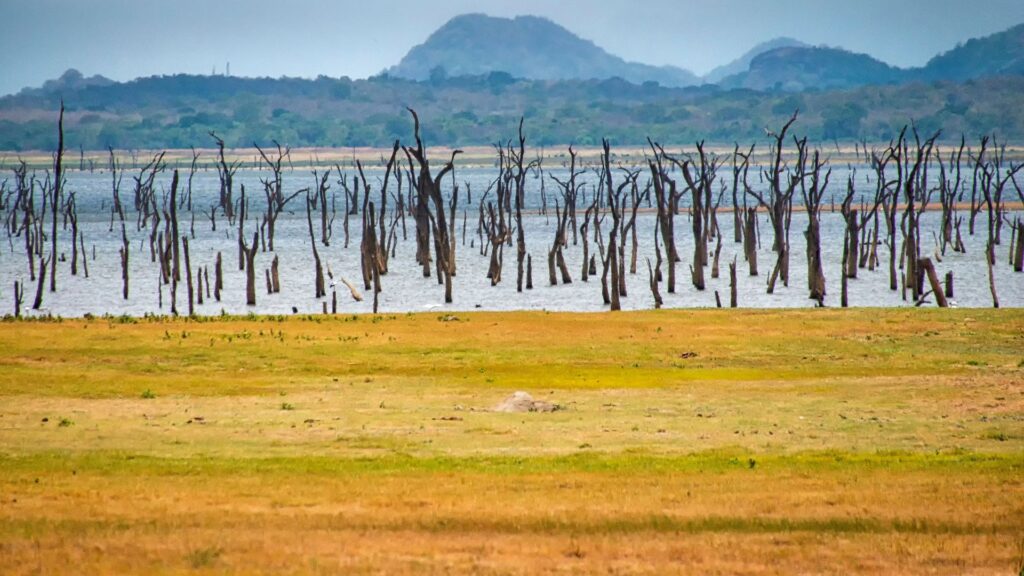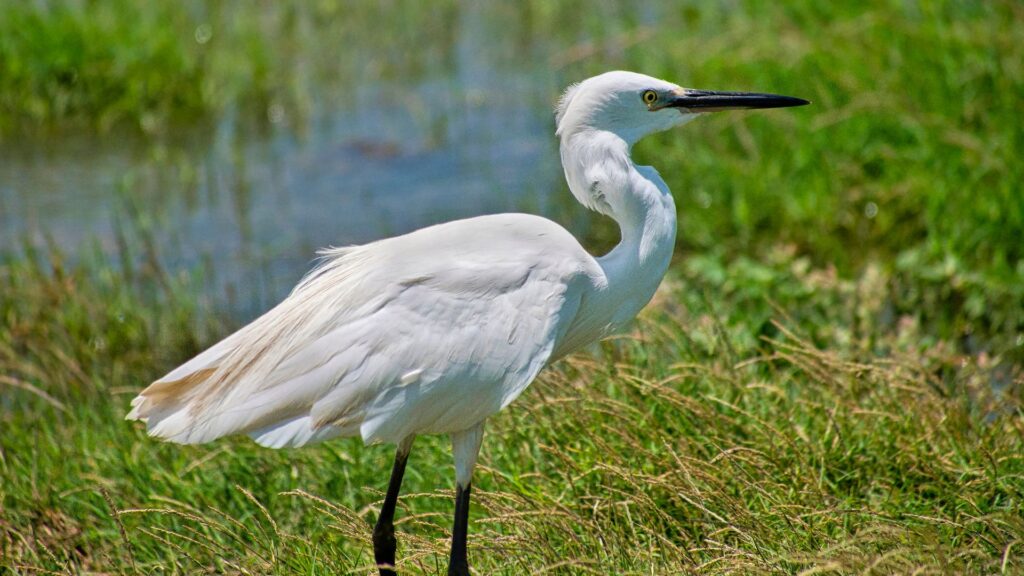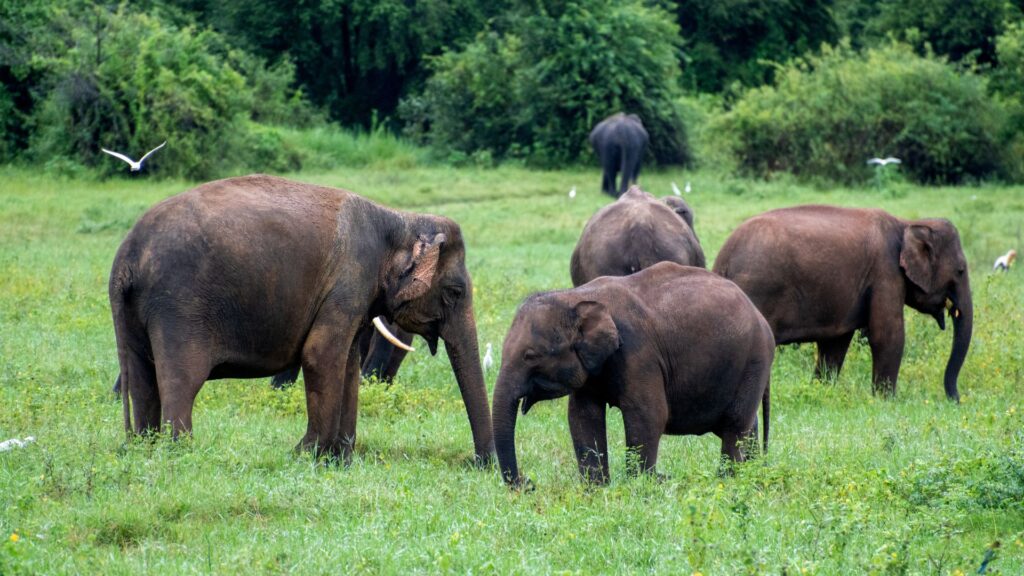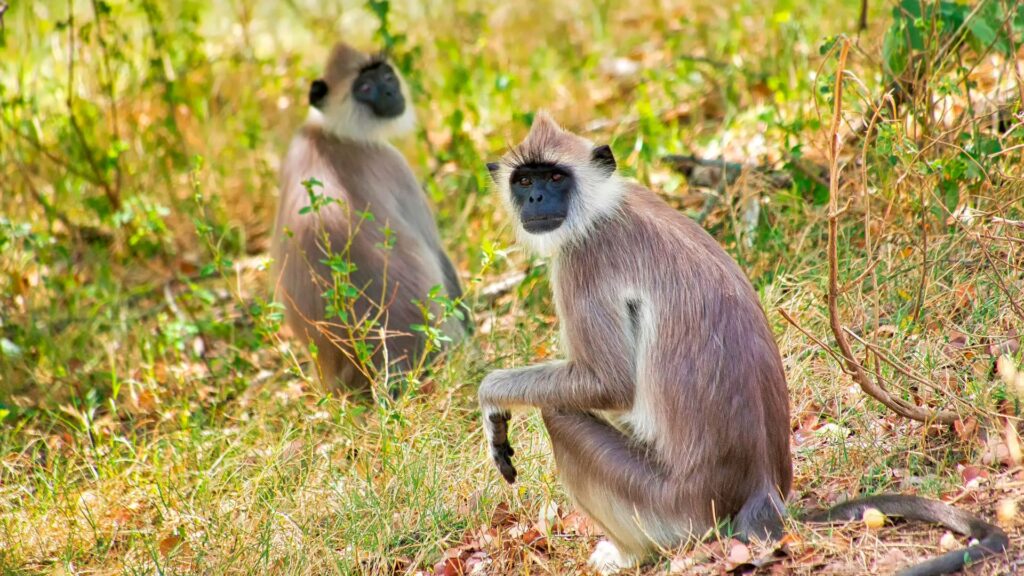Exploring the Wild: A Journey Through Kaudulla National Park, Sri Lanka
Located in the North central province of Sri Lanka, Kaudulla National Park stands as a testament to the island’s rich biodiversity and natural beauty.
This protected area has garnered a well-deserved reputation as a wildlife wonderland, drawing nature enthusiasts and conservationists alike to its lush landscapes and diverse ecosystems.
Kaudulla National Park: A Part of Wildlife Corridor

Established in 2002, Kaudulla National Park encompasses approximately 6,900 hectares of land, making it one of the lesser-known yet unique destinations in Sri Lanka’s wildlife tourism circuit.
The park is situated in the Polonnaruwa district and is part of the larger eco-complex that includes Minneriya and Wasgamuwa National Parks, forming a crucial corridor for wildlife migration.
Brief History and Significance as a Conservation Hotspot
The history of Kaudulla is intertwined with efforts to protect and preserve Sri Lanka’s natural heritage. Originally used as a reservoir for irrigation purposes, the area was later designated as a national park to safeguard its diverse flora and fauna.
Kaudulla plays a vital role in the conservation of several endangered species, including the majestic Asian elephant, which finds sanctuary within its boundaries.
What Makes Kaudulla a Must-Visit Destination
- Elephant Gathering: One of the park’s most remarkable attractions is the annual elephant gathering, where hundreds of elephants congregate during the dry season (from August to December). This spectacle, known as “The Gathering,” offers a rare opportunity to witness these gentle giants in their natural habitat, creating unforgettable memories for visitors (Note: Depending on the grass beds, elephants might prefer Minneriya National Park as well).
- Rich Biodiversity: Beyond elephants, Kaudulla is home to a myriad of wildlife species, including leopards, sloth bears, sambar deer, and a diverse array of birdlife. Birdwatchers will delight in spotting endemic and migratory birds, such as the painted stork, Gray-headed fish eagle, and the vibrant Indian peafowl.
- Scenic Landscapes: The park’s picturesque landscapes are characterized by expansive grasslands, serene lakes, and dense forests, providing a stunning backdrop for wildlife safaris and nature walks. Visitors can explore the park’s beauty while immersing themselves in the sights and sounds of the wilderness.
- Conservation Initiatives: Kaudulla National Park is not only a tourist destination but also a hub for conservation efforts. Park authorities and local communities work together to protect the park’s natural resources, promote sustainable tourism practices, and raise awareness about the importance of preserving Sri Lanka’s ecological heritage.
Fauna & Flora

Kaudulla National Park in Sri Lanka is a haven for biodiversity, boasting a rich tapestry of fauna and flora that attract visitors from around the world. Let’s look into the wild encounters and botanical treasures that await you in this natural paradise.
Wild Encounters: The Diverse Wildlife of Kaudulla
At the heart of Kaudulla’s allure is its diverse wildlife, showcasing an array of species that thrive within its protected boundaries. From majestic elephants to elusive leopards, the park offers a glimpse into Sri Lanka’s vibrant ecosystem.
Elephant Herds: Witness Majestic Giants in Their Natural Habitat
Kaudulla is renowned for its elephant gatherings, especially during the dry season when herds congregate near the reservoirs in search of water and food. Watching these majestic giants roam freely in their natural habitat is a highlight for visitors, offering unforgettable moments and photographic opportunities.

Birdwatcher’s Paradise: Spotting Rare Avian Species
Bird enthusiasts will be delighted by Kaudulla’s avian diversity, with over 200 species recorded within the park. From colorful kingfishers to soaring eagles, the park is a paradise for birdwatching. Keep an eye out for endemic species such as the Sri Lanka junglefowl, Sri Lanka Wood shrike, Sri Lanka Green Pigeon, and water birds such as Painted stork, and Gray-headed fish eagle, adding to the thrill of every sighting.
Reptile Realm: Discovering Snakes, Crocodiles, and More
The reptile population in Kaudulla is equally captivating, with sightings of snakes, monitor lizards, and crocodiles adding an element of adventure to your wildlife experience. Don’t miss the endemic lizard, the Painted lip Lizard on tree trunks. Observing these creatures in their natural habitats provides insights into their behaviors and adaptations to the park’s ecosystem.
Flora Diversity: A Botanical Treasure Trove
Beyond its fauna, Kaudulla is a botanical treasure trove, boasting a diverse range of plant species that contribute to the park’s ecological richness. From towering trees to colorful blooms, the flora of Kaudulla adds to the scenic beauty and supports the park’s wildlife populations.

Navigating the Journey: How to Reach Kaudulla National Park
Planning a trip to Kaudulla National Park in Sri Lanka involves navigating through the island’s scenic landscapes and discovering the best routes to reach this wildlife paradise. Here’s a guide to help you find your way to Kaudulla, whether you’re traveling from major cities or exploring the island’s hidden gems.
Accessible Routes from Major Cities
- From Colombo: If you’re starting your journey from Colombo, the capital city of Sri Lanka, you can opt for a scenic road trip that takes approximately 4 to 5 hours. The route passes through lush countryside and small towns, offering glimpses of rural life along the way.
- From Polonnaruwa: For those already exploring the ancient wonders of Polonnaruwa, reaching Kaudulla is a short distance away, about 25 kilometers or a 45-minute drive. This makes it convenient to include a visit to Kaudulla in your itinerary if you’re touring the cultural triangle of Sri Lanka.
Transportation Options Ranging from Adventurous Drives to Guided Tours
- Self-Drive: If you prefer the freedom of exploring at your own pace, renting a car or hiring a driver is a popular choice. The roads leading to Kaudulla are generally well-maintained, offering a smooth driving experience.
- Guided Tours: Joining a guided tour or safari is another excellent way to reach Kaudulla National Park. Zigma Tours offer organized tours that include transportation, park entry, and knowledgeable guides who can enhance your wildlife experience with their insights, especially with a scientific touch..
- Public Transport: While less common, public buses and trains connect major cities to nearby towns like Habarana and Minneriya, from where you can arrange for local transportation to Kaudulla. Keep in mind that this option may require more planning and flexibility with schedules.
Insider Tips for a Seamless and Enjoyable Journey to the Park
- Timing is Key: Plan your visit during the dry season (fromJuly to October) to increase your chances of witnessing the famous elephant gathering at Kaudulla. This is when wildlife sightings are at their peak, offering an unforgettable safari experience.
- Pack Essentials: Be prepared for a day in the wilderness by packing essentials such as sunscreen, insect repellent, comfortable clothing, sturdy shoes, and a camera or binoculars for wildlife spotting.
- Respect Wildlife: When exploring Kaudulla, maintain a respectful distance from the animals and follow the guidance of your guides or park authorities to ensure the safety of both visitors and wildlife.
By choosing the right route, transportation mode, and planning ahead with insider tips, your journey to Kaudulla National Park can be a seamless and enjoyable adventure filled with wildlife encounters and natural wonders.
If you join us for a wildlife tour you can enjoy the entire journey without any hassles on booking safari jeeps and buying entry tickets etc.
Geographic Features
Kaudulla National Park in Sri Lanka is not just a National Park for wildlife but also a showcase of diverse geographic features that contribute to its natural beauty and ecological significance. Let’s take a closer look at the key geographic elements that define this National Park.
The Heart of the Park: Kaudulla Reservoir
At the core of Kaudulla National Park lies the Kaudulla Reservoir, a vital water source that sustains the park’s ecosystem and attracts a myriad of wildlife, especially during the dry season. The reservoir not only provides essential hydration for animals but also creates picturesque scenes where elephants and other wildlife gather for drinking and bathing, offering unforgettable moments for visitors.
Lush Greenery: Exploring the Park’s Dense Forests
Kaudulla is adorned with lush forests that add a sense of mystique and tranquility to the landscape. These dense forests are home to a variety of flora and fauna, including endemic plant species, small mammals, and birds. Exploring the park’s forested areas allows visitors to immerse themselves in the sights, sounds, and scents of a thriving natural habitat.
Picturesque Landscapes: Hills, Valleys, and Open Plains
The geographic diversity of Kaudulla extends beyond forests and water bodies to encompass hills, valleys, and open plains. Rolling hills dotted with trees provide scenic viewpoints for observing wildlife and capturing panoramic vistas of the park’s beauty. Valleys and open plains offer expansive spaces where animals roam freely, showcasing the harmony between nature and its inhabitants.
Understanding the Climate of Kaudulla
Understanding the climate of Kaudulla National Park is key to planning a memorable and enjoyable visit. From the best times to experience its natural wonders to how wildlife behavior is influenced by seasonal changes, let’s delve into the weather insights and unique experiences that each season brings to this beautiful park.
Weather Insights: Best Times to Visit Kaudulla
The climate of Kaudulla National Park is characterized by distinct seasons, each offering its own charm and wildlife sightings.
- Dry Season (August to December): This period is considered the best time to visit Kaudulla, especially for witnessing the iconic elephant gatherings near the reservoirs. The weather is generally dry and pleasant, making it ideal for wildlife safaris and outdoor activities.
- Inter-monsoon Season (January to February, March to April): These transitional months can be unpredictable, with occasional rainfall interspersed with sunny days. While wildlife sightings may still be good, visitors should be prepared for varying weather conditions.
- Monsoon Season (May to July): The monsoon brings heavy rains to the region, transforming the landscape into a lush green paradise. While wildlife activities may be less predictable during this time, the park’s scenic beauty is at its peak, offering a different perspective for nature enthusiasts.
Monsoon Magic: Experiencing the Park in Rainy Seasons
Contrary to common belief, visiting Kaudulla during the monsoon season can be a rewarding experience for those who appreciate the magic of nature in full bloom.
- Lush Vegetation: The rains rejuvenate the park’s vegetation, turning it into a vibrant tapestry of greenery. The landscapes transform, offering stunning photographic opportunities and a refreshing ambiance.
- Less Crowds: As the monsoon season is considered the off-peak period for tourism, visitors can enjoy a more tranquil and intimate experience with nature. Wildlife sightings may be fewer but can still be rewarding.
- Birdlife: The monsoon season attracts a variety of bird species, including migratory birds seeking refuge in the park’s wetlands and water bodies. Birdwatchers can relish in spotting rare and colorful avian visitors.
Wildlife Behavior: How Climate Influences Animal Activities
The climate plays a significant role in shaping wildlife behavior in Kaudulla National Park.
- Dry Season: Animals, especially elephants, congregate near water sources, offering excellent opportunities for observing their behaviors such as bathing, social interactions, and grazing.
- Monsoon Season: Some animals may be more elusive during heavy rains, seeking shelter in dense vegetation. However, the park’s water bodies remain essential for wildlife survival, attracting a variety of species.
- Inter-monsoon Season: Wildlife activities can vary during this transitional period, with animals adapting to changing weather patterns. Flexible safari schedules and guided tours with an experienced Zigma Tour Team can enhance wildlife sightings during this time.
Dos and Don’ts in the Park
Exploring Kaudulla National Park is a thrilling adventure, but it’s essential to follow certain guidelines to ensure a safe, respectful, and eco-friendly experience. Here are some dos and don’ts to keep in mind during your visit to this natural paradise.
Etiquette Essentials: Respecting Nature and Wildlife
- Do maintain a respectful distance from wildlife and refrain from feeding or approaching animals.
- Don’t litter or leave behind any waste. Carry out all trash and dispose of it responsibly.
- Do follow designated trails and paths to minimize disturbance to the park’s ecosystem.
- Don’t make loud noises or engage in disruptive behavior that may stress wildlife or other visitors.
Safety First: Guidelines for a Secure Visit
- Do listen to and follow instructions from park rangers and guides for your safety.
- Don’t venture off-trail or into restricted areas for your own protection and to avoid disturbing wildlife habitats.
- Do carry essentials such as water, sunscreen, insect repellent, and a first aid kit.
- Don’t approach wild animals or attempt to touch them, as they may perceive it as a threat.
Eco-Friendly Practices: Contributing to Conservation Efforts
- Do support eco-friendly tourism practices by choosing responsible tour operators such as Zigma Tours and accommodations.
- Don’t purchase products made from endangered species or contribute to illegal wildlife trade.
- Do minimize your carbon footprint by opting for sustainable transportation options and reducing plastic usage.
- Don’t disturb natural habitats or remove plants, rocks, or artifacts from the park.
By adhering to these dos and don’ts, you not only ensure your own safety and enjoyment but also contribute to the conservation of Kaudulla National Park’s precious biodiversity. Let’s cherish and protect this natural treasure for generations to come.
We as Zigma Tours contribute 10 % of our profit to local conservation projects. Thus once you are our customer you can be happy and be proud as you contribute to conservation.
Conclusion
Kaudulla National Park is truly a gem for nature lovers. Its diverse wildlife, stunning landscapes, and unique experiences make it a must-visit destination in Sri Lanka.
When planning your trip, consider the best time to visit for optimal wildlife sightings, follow respectful and eco-friendly practices, and prioritize safety.
By immersing yourself in the wonders of Kaudulla, you’ll create lasting memories and deepen your appreciation for the natural world.
